Chapter 10 PDF

| Title | Chapter 10 |
|---|---|
| Course | Statics for Engineering |
| Institution | جامعة الملك فهد للبترول و المعادن |
| Pages | 13 |
| File Size | 123.9 KB |
| File Type | |
| Total Downloads | 31 |
| Total Views | 145 |
Summary
Chapter 1 - Book - Strategic Management Concepts and Cases by Frank Rothaermel...
Description
Managerial Economics, 7e (Keat) Chapter 10 Special Pricing Practices Multiple-Choice Questions 1) A cartel is defined to be A) any oligopolistic industry with fewer than 4 firms. B) a form of oligopoly in which firms agree to sell at different prices like in monopolistic competition. C) a form of oligopoly in which firms formally agree to establish a common strategy, often a common price, in effect acting like a monopoly. D) a form of oligopoly in which firms agree to compete with each other on an equal basis. Answer: C Diff: 1 2) A successful and stable cartel can be established if there are A) many firms producing a storable product. B) many firms producing a perishable product. C) a few firms producing a storable product. D) a few firms producing a perishable product. Answer: C Diff: 2 3) All of the following are conditions which are favorable to the formation of cartels except A) the existence of a small number of firms. B) geographic proximity of firms. C) homogeneity of the product. D) easy entry into the industry. Answer: D Diff: 2 4) Prices under an ideal cartel situation will be equal to A) monopoly prices. B) competitive prices. C) prices under monopolistic competition. D) marginal cost. Answer: A Diff: 2 5) A cartel price will be established at the quantity where A) total cost equals the industry total revenue. B) average cost equals the industry revenue. C) the sum of the members' marginal costs equals industry marginal revenue. D) marginal cost equals industry price. Answer: C Diff: 2 1 Copyright © 2014 Pearson Education, Inc.
6) Cartel agreements tend to break down A) during economic downturns. B) because of price "chiseling" by one or more members. C) when there is overcapacity in the industry. D) All of the above Answer: D Diff: 2 7) The position of a cartel will become weaker if there is ________ excess-capacity among the firms belonging to the cartel. A) minimum B) no C) zero D) high Answer: D Diff: 1 8) Barometric price leadership exists when A) one firm in the industry initiates a price change and the others may or may not follow. B) one firm imposes its best price on the rest of the industry. C) when all firms agree to change prices simultaneously. D) when one company forms a price umbrella for all others. Answer: A Diff: 1 9) Barometric price leadership can occur when oligopolistic firms A) compete on the basis of differentiated products. B) want to avoid price competition and violating antitrust laws. C) try to enforce cartel agreements. D) All of the above Answer: B Diff: 1 10) Dominant price leadership exists when A) one firm drives the others out of the market. B) the dominant firm decides how much each of its competitors can sell. C) the dominant firm establishes the price at the quantity where its MR = MC, and permits all other firms to sell all they want to sell at that price. D) the dominant firm charges the lowest price in the industry. Answer: C Diff: 2
2 Copyright © 2014 Pearson Education, Inc.
11) The oligopolistic situation in which a company's objective is to maximize revenue subject to a minimum profit requirement is usually referred to as A) the aggregate model. B) the Baumol model. C) the aggressive model. D) the Marshall model. Answer: B Diff: 1 12) In the Baumol model, the total quantity sold will usually be larger than A) if perfect competition prevailed. B) if total costs were minimized. C) if profit were maximized. D) if companies were interdependent. Answer: C Diff: 1 13) In the Baumol model, a change in fixed costs will A) increase total quantity sold. B) have no effect on total quantity sold. C) decrease total quantity sold. D) have an effect on total quantity sold. Answer: D Diff: 2 14) In order for price discrimination to exist A) markets must be capable of being separated. B) markets must be interdependent. C) different demand price elasticities must exist in different markets. D) demand price elasticities must be identical in all markets. E) Both A and C Answer: E Diff: 3 15) The result for the seller of being able to practice price discrimination will be A) higher profits. B) lower demand elasticity. C) lower quantity sold. D) cost minimization. Answer: A Diff: 1
3 Copyright © 2014 Pearson Education, Inc.
16) The practice by a monopolist of charging each buyer the highest price he/she is willing to pay is called A) first-degree discrimination. B) second-degree discrimination. C) third-degree discrimination. D) fourth-degree discrimination. Answer: A Diff: 1 17) When state universities charge higher tuition fees to out-of-state students than to local students, the universities are practicing A) first-degree discrimination. B) second-degree discrimination. C) third-degree discrimination. D) fourth-degree discrimination. Answer: C Diff: 2 18) The following are possible examples of price discrimination except A) prices in export markets are lower than for identical products in the domestic market. B) senior citizens pay lower fares on public transportation than younger people at the same time. C) a product sells at a higher price at location A than at location B, because transportation costs are higher from the factory to A. D) subscription prices for a professional journal are higher when bought by a library than when bought by an individual. Answer: C Diff: 3 19) Under conditions of first-degree price discrimination A) production will equal that which would exist under perfect competition. B) production will exceed that which would prevail under perfect competition. C) prices will be lower than under perfect competition. D) production will always be lower than under perfect competition. Answer: A Diff: 2 20) Second-degree price discrimination occurs when A) different prices are charged for different blocks of services. B) different groups of buyers are charged different prices based on their price elasticities of demand. C) a different price is charged for each amount of a product purchased. D) None of the above Answer: A Diff: 2
4 Copyright © 2014 Pearson Education, Inc.
21) Third-degree price discrimination exists when A) the seller knows exactly how much each potential customer is willing to pay and will charge accordingly. B) different prices are charged by blocks of services. C) when the seller can separate markets by geography, income, age, etc., and charge different prices to these different groups. D) when the seller will bargain with buyers in each of the markets to obtain the best possible price. Answer: C Diff: 2 22) By far, the most frequently encountered price discrimination is the A) first-degree price discrimination. B) second-degree price discrimination. C) third-degree price discrimination. D) fourth-degree price discrimination. Answer: C Diff: 2 23) If a product which costs $8 is sold at $10, the profit margin is A) $2. B) 25%. C) 20%. D) None of the above Answer: C Diff: 2 24) If a product which costs $8 is sold at $10, the mark-up is A) $2. B) 25%. C) 20%. D) None of the above Answer: B Diff: 2 25) The correct expression for cost plus pricing is A) Price = Cost (1 + profit margin). B) Price = Cost + profit margin. C) Price = Cost (1 + mark-up). D) Price = Cost + (1 + mark-up). Answer: C Diff: 3
5 Copyright © 2014 Pearson Education, Inc.
26) If the demand elasticity for a product is -2, and a profit-maximizing firm sells the product for $10, its marginal cost must be A) $5. B) $10. C) $15. D) $8. Answer: A Diff: 3 27) When mark-up equals 50% and AC = MC, then demand elasticity will be A) -1. B) -1.5. C) -2. D) -3. Answer: D Diff: 3 28) The pricing of a product at each stage of production as the product moves through several stages is called A) transfer pricing. B) cost plus pricing. C) penetration pricing. D) monopolistic pricing. Answer: A Diff: 1 29) Transfer pricing is a method used to A) determine whether a firm should make or buy a component product. B) determine the correct value of a product as it moves from one stage of production to another. C) minimize a multinational firm's tax liabilities. D) All of the above Answer: D Diff: 2 30) A company which charges a lower price than may be indicated by economic analysis to gain a foothold in the market is practicing A) price skimming. B) psychological pricing. C) penetration pricing. D) prestige pricing. Answer: C Diff: 2
6 Copyright © 2014 Pearson Education, Inc.
31) Assume that a multinational company produces components in country A and ships them to a subsidiary in country B. In order to increase its profits A) the company should charge a high transfer price for the components if income taxes in country B are higher than in country A. B) the company should charge a low transfer price for the components if income taxes in country B are higher than in country A. C) the company should charge a high transfer price for the components if income taxes in country A are higher than in country B. D) None of the above Answer: A Diff: 3 32) Revenue maximization occurs when a firm sells at a price A) that is equal to its minimum average variable cost. B) where its marginal revenue is equal to its marginal cost. C) where its marginal revenue is zero. D) None of the above Answer: C Diff: 2 33) "Tying" is a form of price discrimination which involves a buyer A) agreeing to purchase a product at a fixed price regardless of the amount purchased. B) paying different prices based on the amounts of a product purchased. C) required to buy one product in order to purchase some other product. D) All of the above Answer: C Diff: 2 34) Gasoline and heating oil are examples of products which are A) joint products in fixed proportions. B) joint products in variable proportions. C) joint products that are complements. D) unrelated to each other. Answer: B Diff: 3 35) When a firm sets a price relatively low in order to increase the market share, it is referred as A) price skimming. B) limit pricing. C) penetration pricing. D) predatory pricing. Answer: C Diff: 1
7 Copyright © 2014 Pearson Education, Inc.
36) When a firm prices its goods below the marginal cost to drive away competitors, it is referred as A) price skimming. B) limit pricing. C) penetration pricing. D) predatory pricing. Answer: D Diff: 1 37) A firm uses ________ for goods which the consumer takes pride in owning. A) price skimming B) prestige pricing C) penetration pricing D) predatory pricing Answer: B Diff: 1 38) If a monopolist sets a low price to discourage potential competitors from entering the market, it is referred as A) price skimming. B) predatory pricing. C) penetration pricing. D) limit pricing. Answer: D Diff: 1
8 Copyright © 2014 Pearson Education, Inc.
Analytical Questions 1) Why does each of the following facilitate the creation and stability of a cartel? a. High barriers to entry b. An identical product c. Similar costs Answer: a. A successful cartel implies positive profits. Positive profits attract entry, if it is possible, and increasing the number of firms in the industry erodes the cartel's control and pricing power (or makes it more difficult to negotiate with the larger number of firms in the industry). b. If products are not identical, then consumers may have brand preferences, and thus it is possible for firms to cheat on the cartel by promoting nonprice differences. c. If costs are similar, profits are similar, and the incentives of each firm will be similar, all other things equal. This makes it easier to agree on price and more "fair" in the sense that firms will receive similar profits. 2) Industry demand is given by: QD = 1000 - P All firms in the industry have identical and constant marginal and average costs of $50/unit. a. If the industry is perfectly competitive, what will industry output be? What will be the equilibrium price? What profit will each firm earn? b. Now suppose that there are five firms in the industry, and that they collude to set price. What price will they set? What will be the output of each firm? What will be the profit of each firm? Answer: a. P = 50, so Q = 950. Each firm earns an economic profit of zero. b. MR = 1000 - 2Q. Set MR = MC 50 = 1000 - 2Q Q = 475 P = $525 Each firm produces 1/5 the output, or q = 95. Profit for each firm is $45,125. 3) Why do cartels tend to break up? Answer: There are many reasons, but one of the best is that there is an incentive to cheat. While the cartel maximizes joint profits, individual profit could be increased if the firm could sell more at the cartel price. If everyone does that, output increases and the price falls.
9 Copyright © 2014 Pearson Education, Inc.
4) A monopolist sells to two consumer groups, students and non-students. Demand for students: Q = 500 - 1/2P Demand for non-students: Q = 750 - 2P MC = 20 Find the profit-maximizing price/quantity combination in each market if the groups can be separated. Answer: Students: P = 1000 - 2Q MR = 1000 - 4Q Set MR = MC. 20 = 1000 - 4Q 245 = Q, P = $510 Non-students: P = 375 - 1/2 Q MR = 375 - Q Set MR = MC. 20 = 375 - Q 355 = Q, P = $197.50 5) McDonald's charges a higher price for a Big Mac in New York City than it does in a small town in Iowa. Is this an example of third-degree price discrimination? Explain. Answer: No, or not necessarily. Costs differ between the two markets, because land is more expensive in New York City. Thus the higher price reflects that. 6) Some charge that third-degree price discrimination is unfair or that it reduces social welfare. Why does charging one group a lower price hurt anyone? Answer: There's an equity issue about charging different prices to different people, but the real social welfare issue is not about charging a lower price to one group; it's about charging a higher price to the other. If the firm charged a single price, it would be somewhere in between the two group prices, in most cases. So some customers who would be able to buy at a lower price in the combined market pay more (or do not buy at all) in the separated market. 7) Firms that make game systems like Playstation and Nintendo typically charge a price close to average cost on the game system itself, and do not change that price even when the systems are scarce or demand increases. Why might this be a profit-maximizing strategy? Answer: These firms are selling two products, the systems and the games. These are complementary products. If they increase the price of the systems, they reduce the demand for games (and games are repeat purchases rather than one-time purchases). Additionally, the system is the "hook," or the loss leader that draws customers in. Once you have the system, the switching cost of moving to another system is significant. Thus the systems are cheap, and the games are expensive.
10 Copyright © 2014 Pearson Education, Inc.
8) In the Sunday newspaper, there are usually coupons that you can clip and take to the store to save money on products. Anyone can buy a newspaper, and the value of the coupons easily exceeds the price of the newspaper for most consumers. Is this an example of price discrimination? Explain. Answer: Yes, it is. Consumers with more time are likely to have a more elastic demand for products, and thus they are willing to clip the coupons (and may not buy except at the lower price). Other consumers with less time won't deal with the coupons and thus will pay a higher price. This is essentially the same idea as movie matinee pricing. 9) Would it ever make sense for a firm to charge a price at or below the cost of the product? Answer: This might be an example of penetration pricing in which the firm is trying to gain market share. (Two other reasons not discussed in the text: limit pricing to prevent entry, and predatory pricing to drive out rivals.) 10) Superstar actors typically get contracts that specify that they get a percentage of "the gross," the total revenues that the movie brings in. Why might actors want contracts structured that way? Why might producers be willing to agree to that, and how does this make the goals of actors and producers different? Answer: Actors want to maximize revenue with this sort of contract, while producers wish to maximize profit. It is clearly advantageous to the actor, since cost overruns won't impact what they receive. But it might also suit producers, because if actors are interested in maximizing revenue, they have an incentive to promote the movie and try to increase sales (and to do a product job). This might be more of an incentive than a cut of the profits, over which they have less control. 11) A firm in an oligopolistic industry has the following demand and total cost equations: P = 600 - 20Q and TC = 700 + 160Q + 15Q2 Calculate: a. quantity at which profit is maximized b. maximum profit c. quantity at which revenue is maximized d. maximum revenue e. maximum quantity at which profit will be at least $580 f. maximum revenue at which profit will be at least $580 Answer: If revenue and cost schedules are calculated: a. 6; b. 680; c. 15; d. 4500; e. 8; f. 3520 If results are calculated with equations: a. 6.286; b. 682.86; c. 15; d. 4500; e. 8; f. 3520
11 Copyright © 2014 Pearson Education, Inc.
12) A monopolistic firm operates in two separate markets. No trade is possible between market A and market B. The firm has calculated the demand functions for each market as follows: Market A p = 15 - Q; Market B p = 11 - Q The company estimates its total cost function to be TC = 4Q. Calculate: a. quantity, total revenue and profit when the company maximizes its profit and charges the same price in both markets b. quantity, total revenue and profit when the company charges different prices in each market and maximizes its total profit Answer: If revenue and cost schedules are calculated: a. Q = 9; p = 8.5; TR = 76.5; TC = 36; profit = 40.5 b. Market A: Q = 5 to 6; p = 9 to 10; TR = 50 to 54; TC = 20 to 24; profit = 30 Market B: Q = 3 to 4; p = 7 to 8; TR = 24 to 28; TC = 12 to 16; profit = 12 Combined profit = 42 If equations are used: a. Q = 9; p = 8.5; TR = 76.5; TC = 36; profit = 40.5 b. Market A: Q = 5.5; p = 9.5; TR = 52.25; TC = 22; profit = 30.25 Market B: Q = 3.5; p = 7.5; TR = 26.25; TC = 14; profit = 12.25 Combined profit = 42.5 13) Briefly describe the conditions under which cartels will be formed. Answer: An industry with relatively few firms selling identical or very similar products, where entry is very difficult and cost structures are very similar. Also, geographic proximity of the firms is very helpful. 14) Explain the reasons firms might follow the Baumol model of maximizing revenue subject to achieving a minimum level of profits. Answer: Firms might wish to increase their market shares within the industry, managers' power and prestige tend to grow with an increase in the size of a business' level of operations, eschewing profit maximization might avoid new firms entering the industry and/or pressure for government regulation, and increases in the scale of a firm's level of operation might permit capturing cost economies of scale through greater market power to extract lower prices from the firm's suppliers of inputs.
12 Copyright © 2014 Pearson Education, Inc.
15) Describe the circumstances under which a producer of joint products in fixed proportions might not sell all of one of the available joint products at the profit-maximizing level of operations. Answer: At the profit-maximizing level of output, the demand for that joint product would be such that the price at which it could be sold would involve negative marginal revenue and, hence, a reduction in total profits. Thus sales would be limited to an amount where the last unit sold brings in zero marginal revenue and the remaining units would not be sold (they could be held for sale at a later date if the price might be expected to increase and if the costs of holding the unsold product were less the present value of the expected revenue; otherwise the unsold product would be destroyed).
13 Copyright © 2014 Pearson Education, Inc....
Similar Free PDFs

Chapter 10 quiz #10
- 3 Pages

Notes 10 - Chapter 10
- 5 Pages
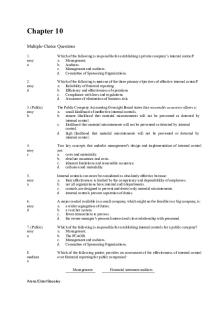
Chapter-10
- 19 Pages
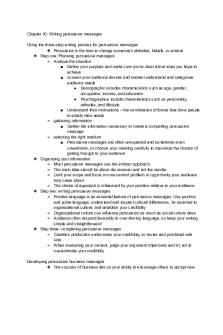
Chapter 10
- 5 Pages
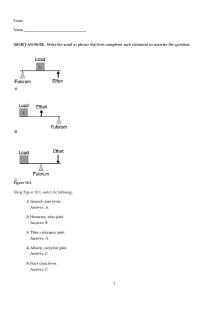
Chapter 10
- 14 Pages

Chapter 10
- 111 Pages
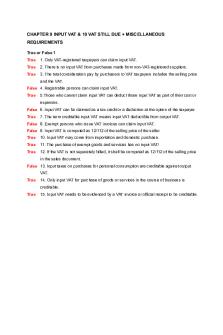
Chapter 10
- 16 Pages
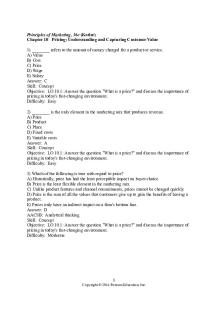
Chapter 10
- 47 Pages
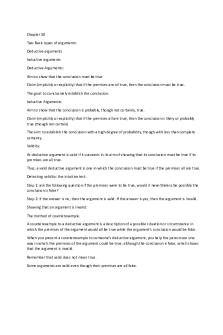
Chapter 10
- 4 Pages
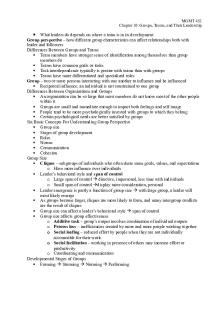
Chapter 10
- 5 Pages
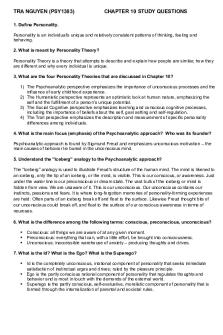
Chapter 10
- 6 Pages

Chapter 10
- 13 Pages

Chapter 10
- 10 Pages

Chapter 10
- 3 Pages

Chapter 10
- 22 Pages
Popular Institutions
- Tinajero National High School - Annex
- Politeknik Caltex Riau
- Yokohama City University
- SGT University
- University of Al-Qadisiyah
- Divine Word College of Vigan
- Techniek College Rotterdam
- Universidade de Santiago
- Universiti Teknologi MARA Cawangan Johor Kampus Pasir Gudang
- Poltekkes Kemenkes Yogyakarta
- Baguio City National High School
- Colegio san marcos
- preparatoria uno
- Centro de Bachillerato Tecnológico Industrial y de Servicios No. 107
- Dalian Maritime University
- Quang Trung Secondary School
- Colegio Tecnológico en Informática
- Corporación Regional de Educación Superior
- Grupo CEDVA
- Dar Al Uloom University
- Centro de Estudios Preuniversitarios de la Universidad Nacional de Ingeniería
- 上智大学
- Aakash International School, Nuna Majara
- San Felipe Neri Catholic School
- Kang Chiao International School - New Taipei City
- Misamis Occidental National High School
- Institución Educativa Escuela Normal Juan Ladrilleros
- Kolehiyo ng Pantukan
- Batanes State College
- Instituto Continental
- Sekolah Menengah Kejuruan Kesehatan Kaltara (Tarakan)
- Colegio de La Inmaculada Concepcion - Cebu
